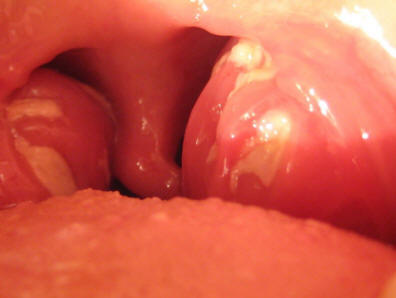Warning: Improving your methylation may trigger an EBV relapse
What is the Epstein Barr Virus?
Many people know the Epstein-Barr virus (EBV), or mononucleosis, as “the kissing disease” because it forms massive reserves in the saliva and mouth and it easily transmitted through kissing. It can also be caught from swimming pools, dirty cutlery and other physical contact. In England it is usually called Glandular fever and in America it is called Mono.
The symptoms are very severe sore throat, and painful inflammation in all the lymph glands, salivary glands, and ovaries. It also causes extreme tiredness which lasts months – usually longer in menstruating women than in men because of the ovary involvement. Long-term EBV infections are associated with higher risk of lymphoma, ovarian cancer, stomach cancer and other types of cancer in the organs it particularly affects.

Some mouldy-looking tonsils with EBV in them. Take it from me, this HURTSHow does it reproduce?
EBV is a retro-virus, which means it inserts itself into a section of your own DNA. In other words, when it infects you, it genetically modifies you. It is part of the Herpes Virus family.
Like all viruses, it is just a small piece of protein that can reproduce itself using the reproductive mechanisms of a living animal’s cells. The Epstein-Barr virus chooses the B-cells of the host’s immune system to reproduce, which is why an infection particularly affects the lymph glands – this is where your B-cells are made. Once it has entered the body it is never eliminated but becomes a latent infection which can recur at any time the immune system is weakened.
Methylation is normally part of the cell’s protective mechanism against retro-viruses. When the cell’s DNA replicates, methylation processes work along it and deactivate viral sequences by methylating them.
EBV is a true wolf in sheep’s clothing, however, because it as learnt to adapt and benefit from being methylated. It actually makes your body OVER-methylate some DNA sequences and this is how it increases the risk of cancer.

The frills all over this human B cell are Epstein-Barr visus in its lysic phase, just about ready to rip the cell apart and go off with flaps of its dead cell wall hanging off them
EBV has three reproductive stages. These were discovered by a German team. You can read their research HERE.
1. In the first prelatent phase the viral DNA acquires nucleosomes, histone marks are established, and 5′-methyl cytosine residues become detectable. In other words, it picks up parts of the infected person’s cell-reproduction equipment.
 2. In the latent phase, repressive histone marks and extensive DNA methylation silence the majority of viral promoters sparing a few latent genes. In other words, at this stage your methylation processes are doing what they are supposed, to, keeping the virus repressed.
2. In the latent phase, repressive histone marks and extensive DNA methylation silence the majority of viral promoters sparing a few latent genes. In other words, at this stage your methylation processes are doing what they are supposed, to, keeping the virus repressed.
3. DNA methylation is a prerequisite for the induction of EBV’s lytic phase in order to escape from latency and give rise to viral progeny. This is the final stage where the virus turns your methylation processes against you, in fact it needs them to be able to break your body cell into pieces, taking parts of the cell wall stuck onto it as another cloak to hide it from your immune system.
So it uses your methylation processes to replicate itself?
So, just to explain it again, here’s what it does:
- EBV must first establish a latent B cell infection in order to keep them alive long enough to produce new viral particles
- EBV DNA is unmethylated upon infection, but becomes methylated over time by the host B cell
- The BZLF1-encoded protein, Zta (a cousin to AP-1), induces the viral lytic cycle (this means part of the reproductive cycle), but it prefers binding sites that are methylated. So the lytic phase gets delayed until enough methylation has occurred.
You can read more about this HERE at Epigenie.com and the original research article HERE on Pubmed.
An article on bloodjournal.org explains how EBV viruses allow themselves to be methylated (by you) as a way of hiding from your immune system:
…methylated EBV DNA can be detected in the normal lymphocytes of healthy volunteers. Whereas methylation of foreign DNA has been recognized as a potential cellular defense mechanism, methylation of EBV DNA may be an essential part of the virus life cycle in vivo, explaining the persistence of virus-infected B cells in the face of immune surveillance.
This is not only how the infection flourishes for so long before the immune system dampens it down, but also how it protects itself from the body’s natural defences once it has triggered cancer, and it explains why cancer cells associated with this virus are partly under-methylated and partly hyper-methylated:
First recognized in tumors, methylation-associated evasion of immune surveillance is not an aberration restricted to tumor tissue but is detected in normal EBV-infected lymphocytes. Methylation of the viral genome in latency also provides an explanation for the CpG suppression associated with EBV but not other large DNA viruses.
What does this mean for patients?
Essentially, anyone with weak methylation (due to genetic polymorphisms and/or altered gene expression) gains the benefit of restricting the ability of a latent EBV viral infection to replicate itself and flare up. Taking supplements to improve methylation can therefore trigger a glandular-fever relapse.
Some anti-herpes antiviral drugs, including Zovirax, can help work against EBV. However, they only affect the virus in the lysic phase, once it has already done a lot of its damage.
A natural aid is to take Lysine supplements. This is an amino acid that the immune system uses to fight against viruses of the herpes family. Against the EBV virus higher doses are needed than for herpes simplex, for example: sometimes 5,000mg a day.
Other articles
The role of promoter methylation in Epstein-Barr virus (EBV) microRNA expression in EBV-infected B cell lines
http://www.nature.com/emm/journal/v43/n7/full/emm201145a.html
Epstein-Barr virus-specific methylation of human genes in gastric cancer cells
http://www.infectagentscancer.com/content/5/1/27
This article explains how the modifications EBV makes to your methylation processes predisposes those cells to become cancerous
http://www.ncbi.nlm.nih.gov/pubmed/25056883
This article appeared first at I Hate Ticks.Me – check out their website for more information on Lyme disease, gut issues and immunity. The Sicilian Housewife had Lyme for 26 years before getting a diagnosis for her and her autistic son. You can also see her personal blog about her adventures in Italy.




